Investigation of Progressive Learning within a Statics Course: An Analysis of Performance Retention, Critical Topics, and Active Participation
Abstract
1. Introduction
2. Objective and Scope
3. Background of Statics
3.1. Statics Topics and Their Interrelations
3.2. Hypothesis
4. Data Collection
4.1. Data Source and Attributes
4.2. Data Preparation
- Highly similar sequence between the solution manual and student homework while there are multiple possible sequences to be taken.
- Equation/solution details (e.g., order of values in equations, use of notations).
- High similarity of FBD and/or figures between solution manual and homework.
- Skipping steps covered in class to solve the problem.
- Different notation and sign conventions compared to the instructor’s teaching.
5. Analysis, Results, and Discussion
5.1. Performance Retention
5.1.1. Exam Performance Retention
- High scores on exam 1: Out of the 80 students in this group, 65 (81.2%) maintained a high score on exam 2; and of these 65 students, 50 (76.9%) maintained a high score in exam 3. Not a single student in this group failed the course; 70% obtained a final grade of A; and 90% obtained a final grade of B or better. These findings demonstrate that a high proportion of students who developed a good understanding early on are more likely to retain the same level of high performance and successfully complete the course without failing. This indicates that performance retention is clearly found among students who build a good understanding from the beginning. In other words, early-on understanding is critical in this course for knowledge progression and retention.
- Medium scores on exam 1: Out of the 55 students in this group, 46 (83.6%) achieved the same or better levels (i.e., medium or high) of performance on exam 2; out of these 46 students, 39 (84.7%) achieved a medium or high score on the final exam 89% of the students in this group successfully passed the course, with 11% of the students in this group failing. More specifically, 16% obtained a final grade of A, which is significantly less than that of the students who received high scores on exam 1 while 61.8% of the students in this group received a grade of B or better for the final grade. These results indicate that students who develop an acceptable level of understanding early on either maintained or improved on that performance. Most of them achieved acceptable final grades and successfully completed the course without failing. However, depending on their follow-up progression, some students in this group may still fail the course or achieve a high final grade.
- Low scores on exam 1: Out of the 60 students in this group, 37 (61.6%) obtained a low score on exam 2; out of these 37 students, 35 (94.5%) maintained the low score in exam 3. Moreover, 67% of the students in this group failed the course, and only 3% obtained a final grade of A. From exam 1 to exam 2, about 30% of the students improved their performance. However, from exam 2 to exam 3, only 5% improved their performance. This indicates that low performance on exam 1 is strongly associated with the continuous low performance, and low performance on exam 2 is extremely strongly associated with the continuous low performance. This suggests that building a weak understanding from the beginning makes it difficult for them to recover or properly learn. Although some students may overturn low performance on exam 1 and achieve satisfactory or high final grades, the number of such students is insignificant.
5.1.2. Homework Performance Retention
- High scores on homework set 1: From the 128 students in this group, 82 (64.1%) maintained a high score on homework set 2; from these 82 students, 64 (78.1%) maintained a high score on homework set 3. Approximately 80% of the students in this group passed the course, and 42% obtained a final grade of A. These findings demonstrate that students who develop a good understanding from the beginning retain the same level of high performance till the end, and most of them successfully complete the course without failing. This result generally corroborates our findings related to exam performance retention that performance retention is clearly found among students who build a good understanding from the beginning. However, there is a notable number of students, worth noting, who had a significant drop in performance to low homework performance from homework set 2. An additional, separate analysis indicates that many students from this group performed poorly on exam 1. Although we are unable to prove this with hard evidence or data, these students may have learned completion of homework without a proper understanding of the material is not helpful for their exam performance and overall knowledge retention, and stopped using extra resources (e.g., solutions’ manual) to complete their homework.
- Medium scores on homework set 1: In total, 44 students were identified to initially be in this group. As this is the medium performing group, the spread of the performance on the next homework sets covers more broadly than the other groups. Considering the performance in homework set 2, the 44 students are distributed to 24, 14, and 6 in low, medium and high groups (L2, M2, and H2), respectively. A larger proportion is found in the low performance (L2) group from M1. The same true considering the third homework set: there are more students in L3 than the other groups, M3 and H3. From this student distribution in subsequent homework sets, we claim a medium level performance presents challenges to improve performance in subsequent learning; however, it is not impossible to improve as a small portion of students were able to improve their performance while majority struggled with lower performance. From this group (M1), 22% of the students received an A grade, 32% failed the course, and 68% passed the course. Given the importance of initial topics of statics serving the fundamental basis of later topics, these results are deemed reasonable.
- Low scores on homework set 1: From the 23 students in this group, 20 (86.9%) maintained the same level of performance at a low score on homework set 2; from these 20 students, 17 (85%) maintained a low score on homework set 3. Moreover, 44% of students in this group—a significant portion—failed the course and only 19% obtained a final grade of A. These findings demonstrate that on homework, almost all students who develop a poor understanding early on retain the same level of low performance on subsequent assessments, and almost half of the students fail to pass the course. This corroborates exam retention findings that performance retention negatively builds among students who attain a poor understanding from the beginning.
5.2. Critical Topics
5.2.1. Critical Topics for All Failing Students
- Based on Figure 7, from homework 4 to homework 5, the gap in scores for the failing students experienced the most drastic increase.
- Based on Figure 6, from homework 5 to the following homework assignments, there is no significant increase in performance, which implies that the students continue to suffer at a low grade.
- The failing students maintained a constantly low performance on homework 5 to 9 at 62.0, 49.6, 49.6, 56.3, and 47.3, respectively.
- On homework 8, their performance improved; however, on homework 9, again, a significant drop in performance occurs.
5.2.2. Critical Topics for Continuously Low-Performing Students
5.3. Progressive Course Interaction
5.3.1. Active Participation
5.3.2. Attendance
6. Discussion
7. Conclusions
Author Contributions
Funding
Institutional Review Board Statement
Informed Consent Statement
Data Availability Statement
Conflicts of Interest
References
- Roy, J.; Wilson, C. Engineering and Engineering Technology by the Numbers 2019; ASEE: Washington, DC, USA, 2019. [Google Scholar]
- NCES. Undergraduate Enrollment. Condition of Education; U.S. Department of Education, Institute of Education Sciences; National Center for Education Statistics: Washington, DC, USA, 2020.
- Aulck, L.; Velagapudi, N.; Blumenstock, J.; West, J. Predicting Student Dropout in Higher Education. arXiv 2016, arXiv:1606.06364. [Google Scholar] [CrossRef]
- Chen, Y.; Johri, A.; Rangwala, H. Running out of STEM. In Proceedings of the 8th International Conference on Learning Analytics and Knowledge, Sydney, Australia, 7–9 March 2018; ACM: New York, NY, USA; pp. 270–279. [Google Scholar] [CrossRef]
- Casanova, J.R.; Cervero, A.; Núñez, J.C.; Almeida, L.S.; Bernardo, A. Factors that determine the persistence and dropout of university students. Psicothema 2018, 30, 408–414. [Google Scholar] [CrossRef] [PubMed]
- Brandi, N.G.; Raman, D.R. Why They Leave: Understanding Student Attrition from Engineering Majors-Web of Science Core Collection. Int. J. Eng. Educ. 2013, 29, 914–925. [Google Scholar]
- Ghanat, S.T.; Davis, W.J. Assessing Students’ Prior Knowledge and Learning in an Engineering Management Course for Civil Engineers. In Proceedings of the ASEE Annual Conference and Exposition, Conference Proceedings, Tampa, FL, USA, 15 June–19 October 2019. [Google Scholar] [CrossRef]
- Moty, B.; Baronio, G.; Speranza, D.; Filippi, S. TDT-L0 a Test-Based Method for Assessing Students’ Prior Knowledge in Engineering Graphic Courses. Lect. Notes Mech. Eng. 2020, 1, 454–463. [Google Scholar] [CrossRef]
- Ghanat, S.T.; Kaklamanos, J.; Selvaraj, S.I.; Walton-Macaulay, C.; Sleep, M. Assessment of Students’ Prior Knowledge and Learning in an Undergraduate Foundation Engineering Course. In Proceedings of the ASEE Annual Conference and Exposition, Conference Proceedings, Columbus, OH, USA, 24–28 June 2017. [Google Scholar] [CrossRef]
- Smith, N.; Myose, R.; Raza, S.; Rollins, E. Correlating Mechanics of Materials Student Performance with Scores of a Test over Prerequisite Material; ASEE North Midwest Section Annual Conference 2020 Publications; ASEE: Washington, DC, USA, 2020. [Google Scholar]
- Derr, K.; Hübl, R.; Ahmed, M.Z. Prior knowledge in mathematics and study success in engineering: Informational value of learner data collected from a web-based pre-course. Eur. J. Eng. Educ. 2018, 43, 911–926. [Google Scholar] [CrossRef]
- Saher, R.; Stephen, H.; Park, J.W.; Sanchez, C.D.A. The Role of Prior Knowledge in the Performance of Engineering Students. In Proceedings of the ASEE Annual Conference and Exposition, Conference Proceedings, Virtual Conference, 26 July 2021. [Google Scholar]
- Durandt, R. Connection between Prior Knowledge and Student Achievement in Engineering Mathematics. In Proceedings of the ISTE—International Conference on Mathematics, Phalaborwa, South Africa, 23–26 October 2017. [Google Scholar]
- Nelson, K.G.; Shell, D.F.; Husman, J.; Fishman, E.J.; Soh, L.K. Motivational and self-regulated learning profiles of students taking a foundational engineering course. J. Eng. Educ. 2015, 104, 74–100. [Google Scholar] [CrossRef]
- Besterfield-Sacre, M.; Atman, C.J.; Shuman, L.J. Characteristics of Freshman Engineering Students: Models for Determining Student Attrition in Engineering. J. Eng. Educ. 1997, 86, 139–149. [Google Scholar] [CrossRef]
- Dollar, A.; Steif, P.S. Learning modules for the statics classroom. In Proceedings of the ASEE Annual Conference Proceedings, Nashville, TN, USA, 22–25 June 2003; pp. 953–960. [Google Scholar] [CrossRef]
- Hanson, J.H.; Williams, J.M. Using Writing Assignments to Improve Self-Assessment and Communication Skills in an Engineering Statics Course. J. Eng. Educ. 2008, 97, 515–529. [Google Scholar] [CrossRef]
- Danielson, S.G.D.E. Problem solving: Improving a critical component of engineering education. In Proceedings of the Creativity: Educating World-Class Engineers; Proceedings, 1992 Annual Conference of the ASEE, Worcester, MA, USA, 11–13 June 1992; Volume 2, pp. 1313–1317. [Google Scholar]
- Mejia, J.A.; Goodridge, W.H.; Call, B.J.; Wood, S.D. Manipulatives in engineering statics: Supplementing analytical techniques with physical models. In Proceedings of the ASEE Annual Conference and Exposition, Conference Proceedings, New Orleans, LA, USA, 26–29 June 2016. [Google Scholar] [CrossRef]
- Danielson, S. Knowledge Assessment In Statics: Concepts Versus Skills. In Proceedings of the 2004 Annual Conference Proceedings, Salt Lake City, UT, USA, 20–23 June 2004; pp. 9.834.1–9.834.10. [Google Scholar] [CrossRef]
- Lewis, M.; Terry, R.; Campbell, N. Registering risk: Understanding the impact of course-taking decisions on retention. In Proceedings of the 12th Annual National Symposium on Student Retention, Norfolk, VA, USA, 31 October–3 November 2016; pp. 364–371. [Google Scholar]
- John, B.; Ann, B.; Rodney, C. How People Learn: Brain Mind Experience and School Committee on Developments in the Science of Learning. In Commission on Behavioral and Social Sciences and Education; National Research Council, National Academy Press: Cambridge, MA, USA, 1999; Available online: https://www.nationalacademies.org/home (accessed on 26 February 2023).
- Streveler, R.; Geist, M.; Ammerman, R.; Sulzbach, C.; Miller, R.; Olds, B.; Nelson, M. Identifying and investigating difficult concepts in engineering mechanics and electric circuits. In Proceedings of the ASEE Annual Conference and Exposition, Conference Proceedings, Chicago, IL, USA, 18–21 June 2006. [Google Scholar] [CrossRef]
- Steif, P.S.; Dantzler, J.A. A statics concept inventory: Development and psychometric analysis. J. Eng. Educ. 2005, 94, 363–371. [Google Scholar] [CrossRef]
- Steif, P.S. An articulation of the concepts and skills which underlie engineering Statics. In Proceedings of the 34th Annual Frontiers in Education, Savannah, GA, USA, 20–23 October 2004; Volume 2. [Google Scholar] [CrossRef]
- Steif, P.; Dollar, A. An Interactive Web Based Statics Course. In Proceedings of the 2007 Annual Conference & Exposition Proceedings, Honolulu, HI, USA, 24–27 June 2007; pp. 12.224.1–12.224.12. [Google Scholar] [CrossRef]
- Valstar, S.; Griswold, W.G.; Porter, L. The Relationship between Prerequisite Proficiency and Student Performance in an Upper-Division Computing Course. In Proceedings of the 50th ACM Technical Symposium on Computer Science Education, Minneapolis, MN, USA, 27 February–2 March 2019. [Google Scholar] [CrossRef]
- Soria, K.M.; Mumpower, L. Critical Building Blocks: Mandatory Prerequisite Registration Systems and Student Success. NACADA J. 2012, 32, 30–42. [Google Scholar] [CrossRef]
- Dunn, B.; Fontanier, C.; Goad, C.; Dunn, B.L.; Luo, Q. Student Perceptions of Bonus Points in Terms of Offering, Effort, Grades, and Learning. NACTA J. 2020, 65, 169–173. Available online: https://www.researchgate.net/publication/353368881 (accessed on 17 April 2023).
- Moll, J.; Gao, S. Awarding bonus points as a motivator for increased engagement in course activities in a theoretical system development course. In Proceedings of the 2022 IEEE Frontiers in Education Conference (FIE), Uppsala, Sweden, 8–11 October 2022. [Google Scholar] [CrossRef]
- Prasetyo, Y.T.; Ong, A.K.; Concepcion, G.K.; Navata, F.M.; Robles, R.A.; Tomagos, I.J.; Young, M.N.; Diaz, J.F.; Nadlifatin, R.; Redi, A.A. Determining Factors Affecting Acceptance of E-Learning Platforms during the COVID-19 Pandemic: Integrating Extended Technology Acceptance Model and DeLone & McLean IS Success Model. Sustainability 2021, 13, 8365. [Google Scholar] [CrossRef]
- Lorenzo, C.; Lorenzo, E. Opening Up Higher Education: An E-learning Program on Service-Learning for University Students. Adv. Intell. Syst. Comput. 2020, 963, 27–38. [Google Scholar] [CrossRef]
- Singh, P.; Alhassan, I.; Binsaif, N.; Alhussain, T. Standard Measuring of E-Learning to Assess the Quality Level of E-Learning Outcomes: Saudi Electronic University Case Study. Sustainability 2023, 15, 844. [Google Scholar] [CrossRef]
- Alenezi, A. The role of e-learning materials in enhancing teaching and learning behaviors. Int. J. Inf. Educ. Technol. 2020, 10, 48–56. [Google Scholar] [CrossRef]
- Dospinescu, O.; Dospinescu, N. Perception over E-Learning Tools in Higher Education: Comparative Study Romania and Moldova. In Proceedings of the 19th International Conference on INFORMATICS in ECONOMY Education, Research and Business Technologies, Timisoara, Romania, 21–24 May 2020; Volume 2020, pp. 59–64. [Google Scholar] [CrossRef]

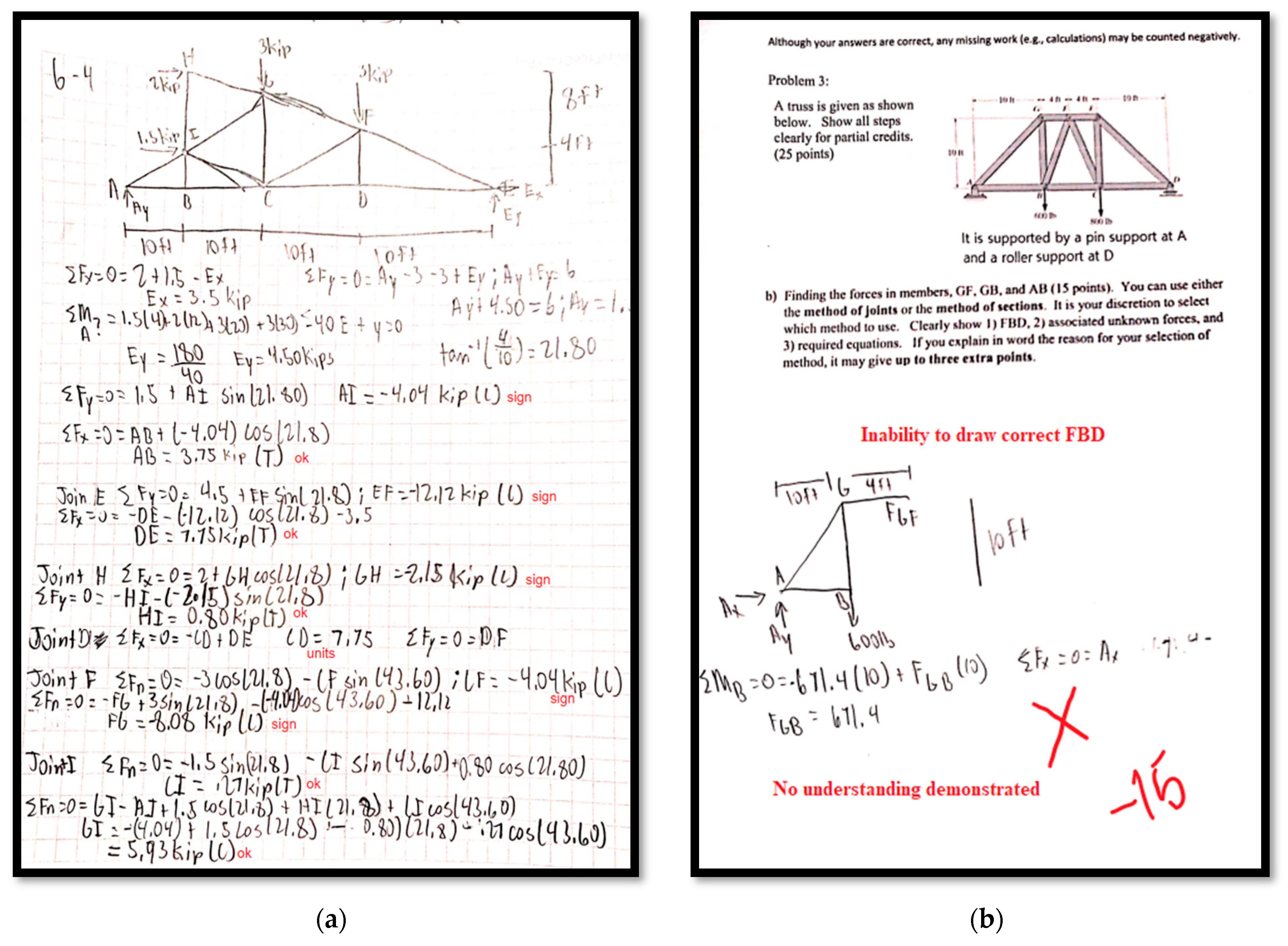

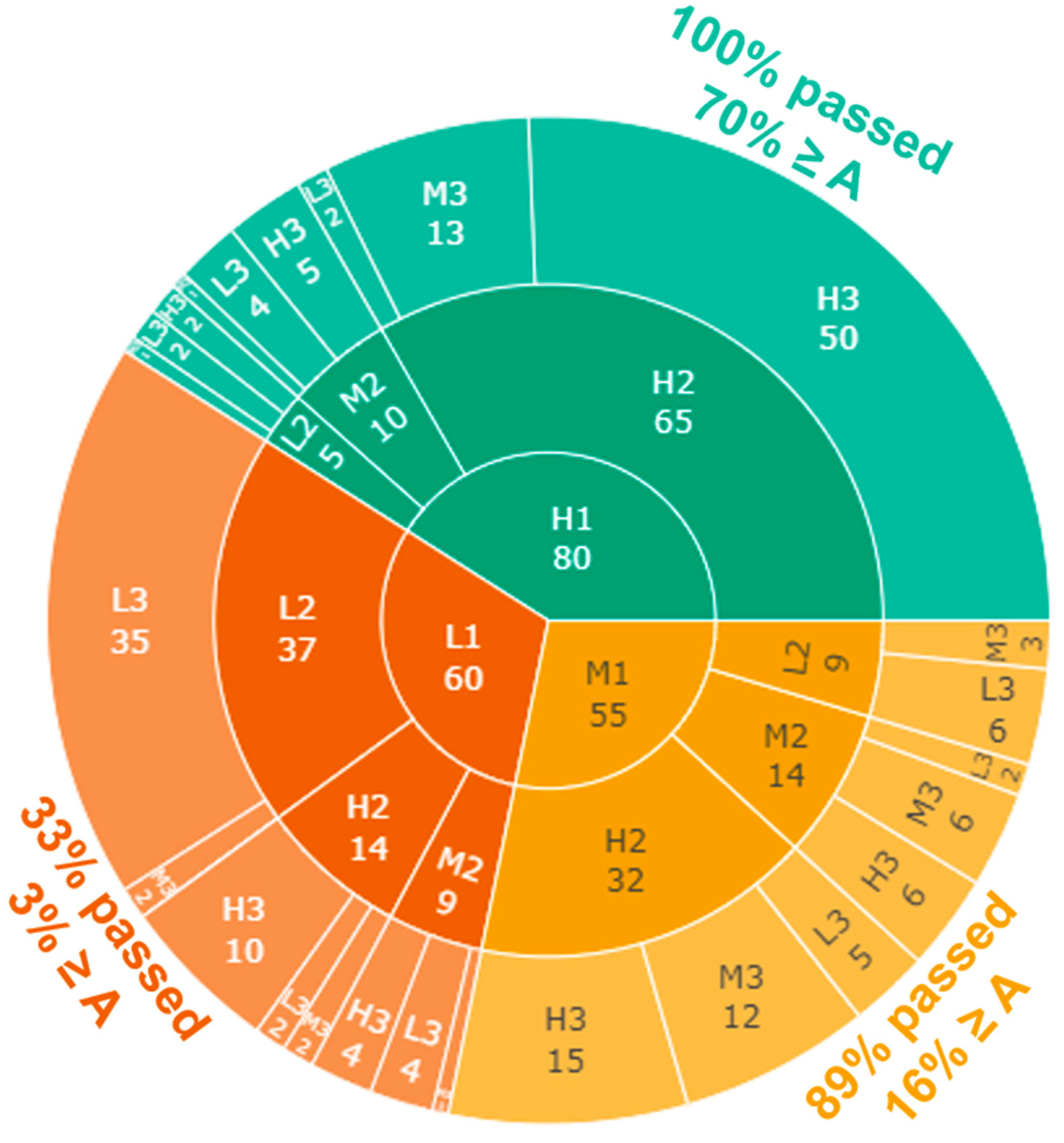


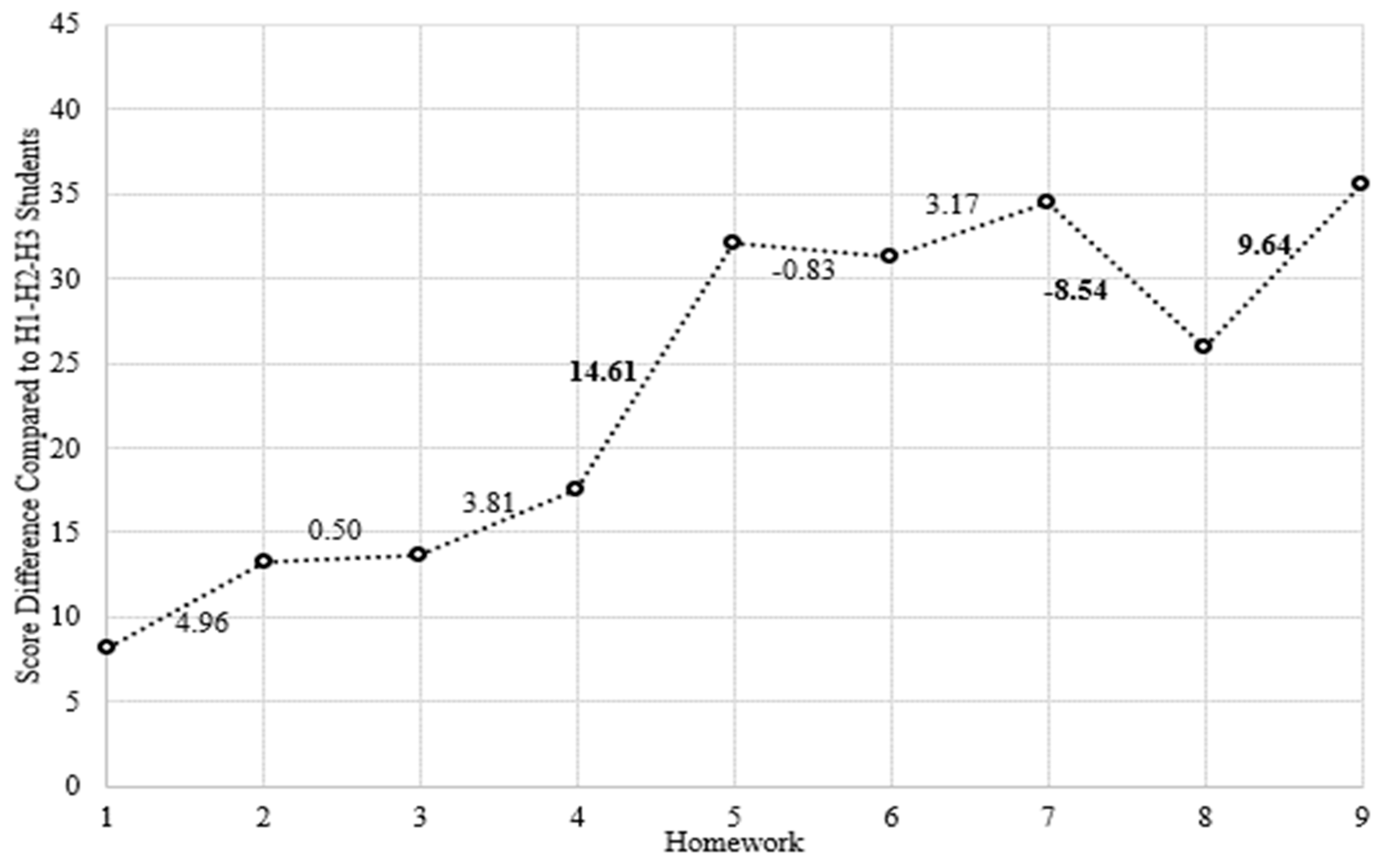
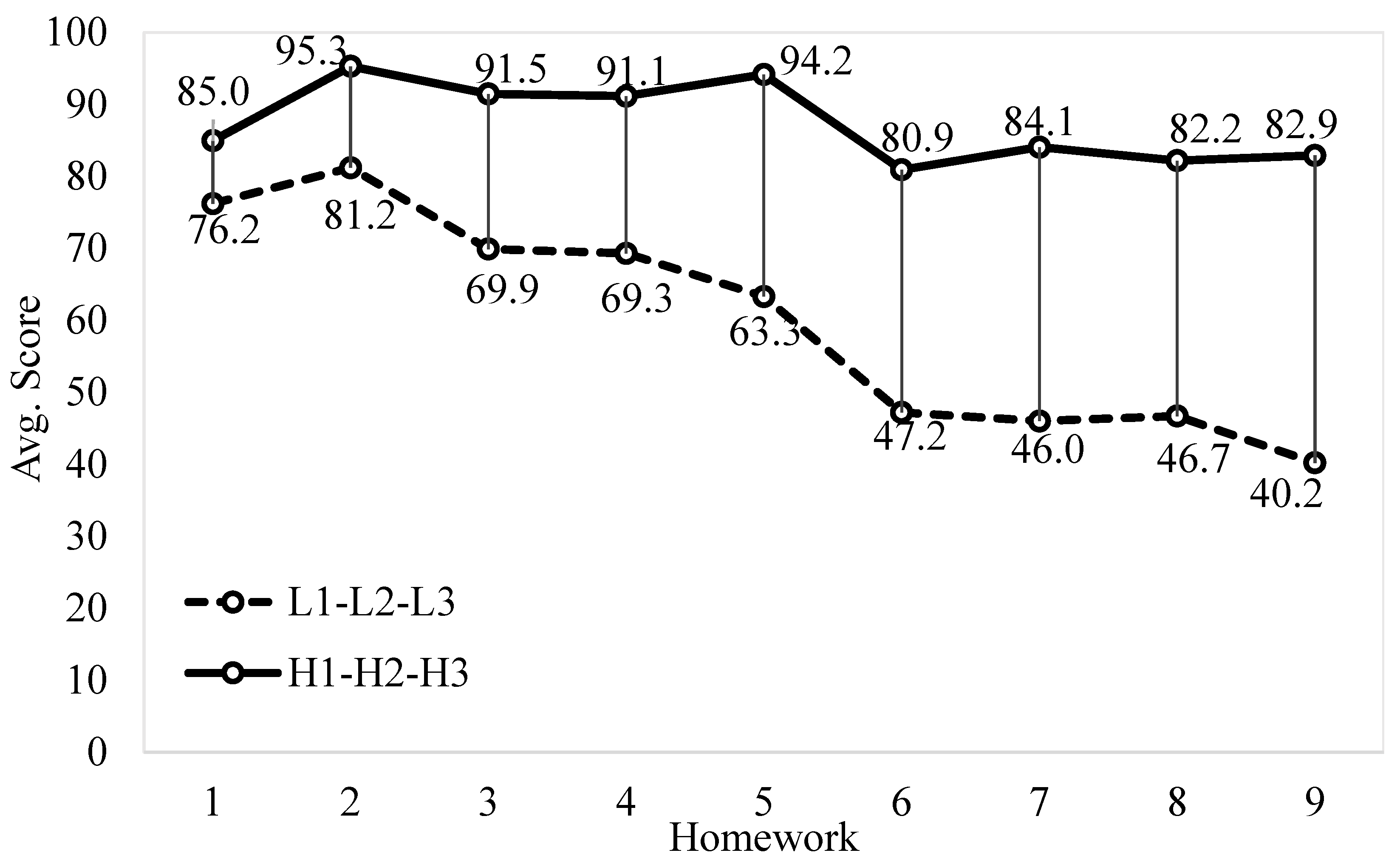

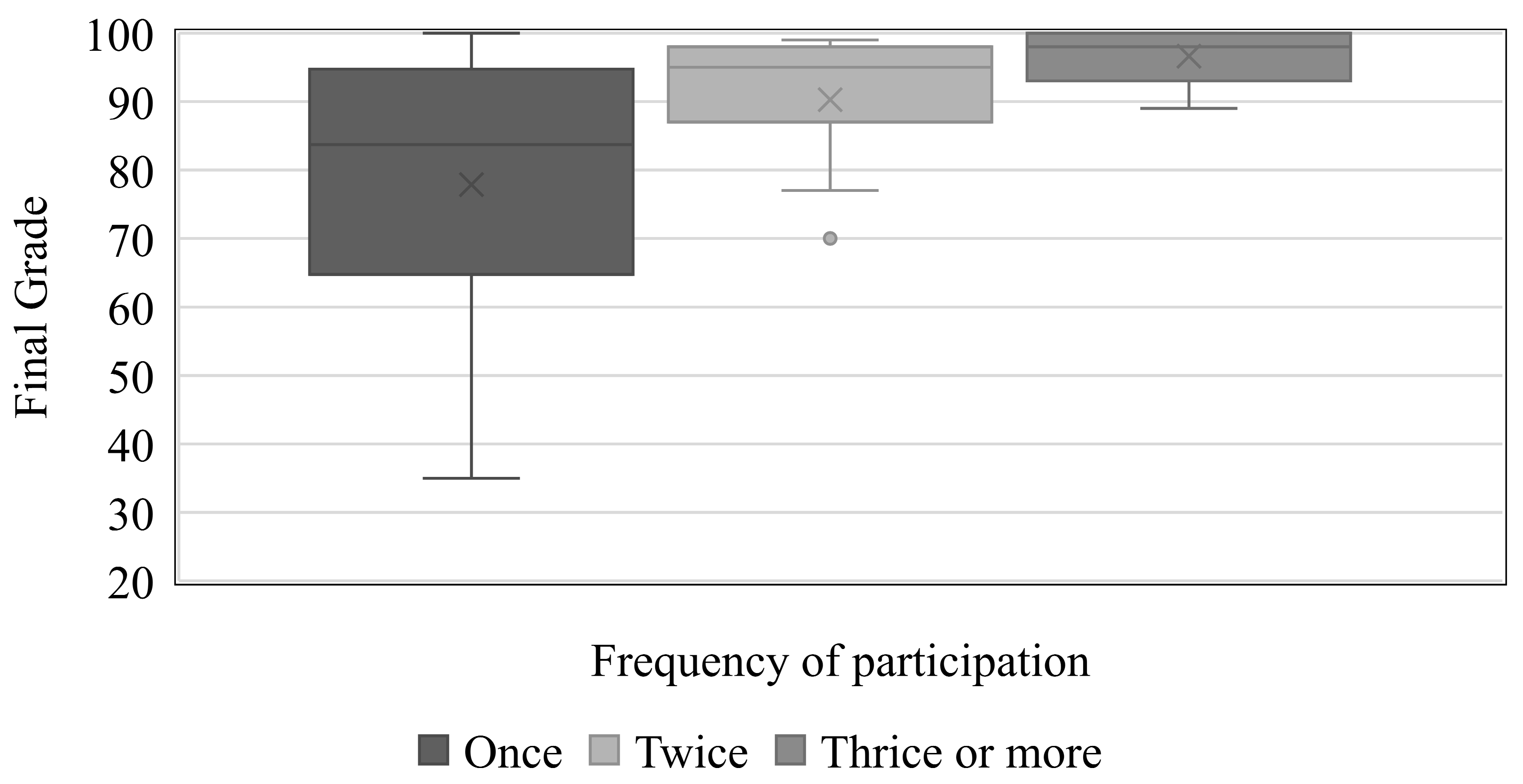
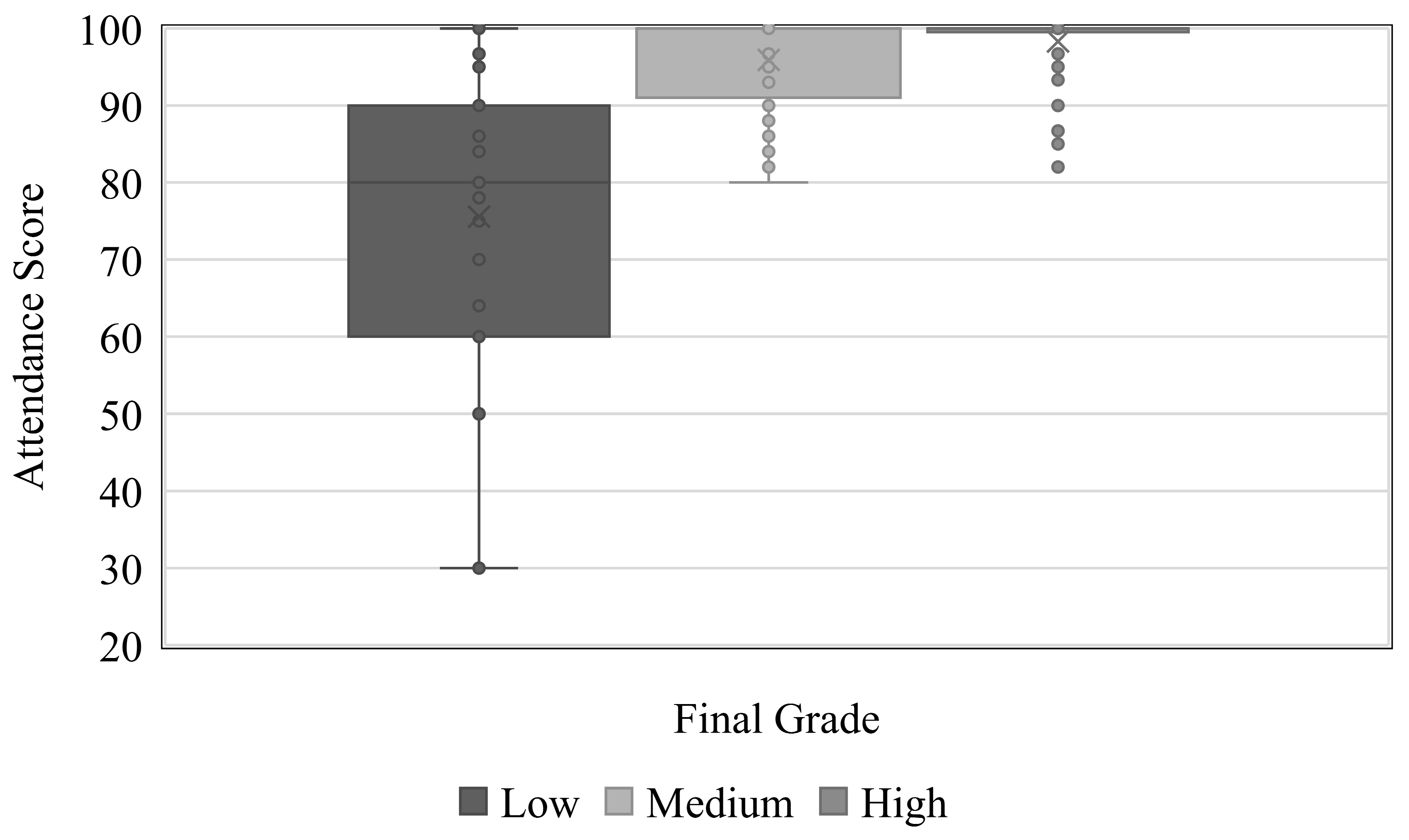
| Topic | Homework | Exam 1 | Exam 2 | Exam 3 |
|---|---|---|---|---|
| Force Vector | 1 | ✓ | ✓ | ✓ |
| Free-body Diagram, Equilibrium | 2 | ✓ | ✓ | ✓ |
| Moment, Varignon’s Theorem, Couple | 3 | ✓ | ✓ | ✓ |
| Load Simplification, Distributed loads | 4 | ✓ | ✓ | ✓ |
| FBD, Equilibrium, Two Force Member, Support | 5 | ✓ | ✓ | |
| Truss, Frames, Friction | 6 | ✓ | ✓ | |
| Internal Forces: Shear and Moment | 7 | ✓ | ||
| Centroid | 8 | ✓ | ||
| Moment of Inertia | 9 | ✓ |
| Performance Category | Performance Score (S) |
|---|---|
| High | S ≥ 85 |
| Medium | 70 ≤ S < 85 |
| Low | S < 70 |
| All Failing Students vs. H1-H2-H3 | p-Value | Significant |
|---|---|---|
| Homework 1 | p = 0.078 | No |
| Homework 2 | p < 0.01 | Yes |
| Homework 3 | p < 0.01 | Yes |
| Homework 4 | p < 0.001 | Yes |
| Homework 5 | p < 0.001 | Yes |
| Homework 6 | p < 0.001 | Yes |
| Homework 7 | p < 0.001 | Yes |
| Homework 8 | p < 0.001 | Yes |
| Homework 9 | p < 0.001 | Yes |
| L1-L2-L3 vs. H1-H2-H3 | p-Value | Significant |
|---|---|---|
| Homework 1 | p = 0.072 | No |
| Homework 2 | p < 0.001 | Yes |
| Homework 3 | p < 0.001 | Yes |
| Homework 4 | p < 0.001 | Yes |
| Homework 5 | p < 0.001 | Yes |
| Homework 6 | p < 0.001 | Yes |
| Homework 7 | p < 0.001 | Yes |
| Homework 8 | p < 0.001 | Yes |
| Homework 9 | p < 0.001 | Yes |
Disclaimer/Publisher’s Note: The statements, opinions and data contained in all publications are solely those of the individual author(s) and contributor(s) and not of MDPI and/or the editor(s). MDPI and/or the editor(s) disclaim responsibility for any injury to people or property resulting from any ideas, methods, instructions or products referred to in the content. |
© 2023 by the authors. Licensee MDPI, Basel, Switzerland. This article is an open access article distributed under the terms and conditions of the Creative Commons Attribution (CC BY) license (https://creativecommons.org/licenses/by/4.0/).
Share and Cite
Ahmed, N.; Park, J.; Arteaga, C.; Stephen, H. Investigation of Progressive Learning within a Statics Course: An Analysis of Performance Retention, Critical Topics, and Active Participation. Educ. Sci. 2023, 13, 576. https://doi.org/10.3390/educsci13060576
Ahmed N, Park J, Arteaga C, Stephen H. Investigation of Progressive Learning within a Statics Course: An Analysis of Performance Retention, Critical Topics, and Active Participation. Education Sciences. 2023; 13(6):576. https://doi.org/10.3390/educsci13060576
Chicago/Turabian StyleAhmed, Naveed, JeeWoong Park, Cristian Arteaga, and Haroon Stephen. 2023. "Investigation of Progressive Learning within a Statics Course: An Analysis of Performance Retention, Critical Topics, and Active Participation" Education Sciences 13, no. 6: 576. https://doi.org/10.3390/educsci13060576
APA StyleAhmed, N., Park, J., Arteaga, C., & Stephen, H. (2023). Investigation of Progressive Learning within a Statics Course: An Analysis of Performance Retention, Critical Topics, and Active Participation. Education Sciences, 13(6), 576. https://doi.org/10.3390/educsci13060576








